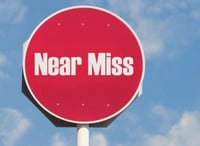Best Practices in Near-Miss and Good-Catch Reporting in Construction
By Aclaimant
Apr 06, 2020
 Many safety directors speak of their need for a better near-miss and/or good-catch program. The key differences between the two are that a near miss describes an incident that didn’t result in an injury or damage, but could have, while a good catch describes a situation where an incident of any type was avoided. Reporting both near misses and good catches can provide valuable, actionable data for preventing future incidents and improving the overall safety metrics of an organization.
Many safety directors speak of their need for a better near-miss and/or good-catch program. The key differences between the two are that a near miss describes an incident that didn’t result in an injury or damage, but could have, while a good catch describes a situation where an incident of any type was avoided. Reporting both near misses and good catches can provide valuable, actionable data for preventing future incidents and improving the overall safety metrics of an organization.
Successful programs share key attributes. Here are things to consider in developing effective near-miss and good-catch programs.
Management Buy-In and Participation
In order for a near-miss or good-catch program to be successful, management must fully support the program. Though financial analysis data supports the economics of investing in safety, it is not always clearly understood. The publication Recommended Practices for Safety and Health Programs from OSHA discusses how to make the case for proactive safety programs.
Non-Punitive/Rewarding
Very few people want to willingly broadcast their mistakes, nor do people want to bring trouble to anyone else. It can be embarrassing, and people feel like they “should have known better.” When near-miss or good-catch reporting is rewarded, it changes this mindset. For example, companies offer points that can be exchanged for gift cards or safety equipment. For tips on talking to employees about the safety hazards identified, read Better Safety Conversations, from OSHA.
Provide Useful Analytics
The goal of near-miss and good-catch reporting is to capture actionable data: leading and lagging indicators that readily illustrate how to prevent future incidents. Many reporting best practices include easily capturing useful data so that it instantly flows into analytics. However, the challenge many contractors face is completing, transferring, and compiling data from the field so that the data gleaned from these important reports are useful.
Easy and Quick Reporting
A key piece of a successful program is the ease in which anyone can report a near miss or a good catch. Systems, like Aclaimant's, should be readily available and responsive on any mobile device as well as available offline. With distributed workforces, it’s essential to provide a way to report and submit near misses and good catches as easily as possible.
Conveniently Implemented
Contractors need to be able to rapidly deploy a program that’s easily available and simple to administer. The more steps it takes to implement a program, the less likely it will be implemented.
Clearly Communicated
This might be the most important component of any successful program. For the program to be successful, the intent and the rules must be clearly communicated to all employees. “No penalty” reporting must be stated and reinforced from the very top. Rewards programs are better as they not only motivate, but communicate, intent. Reminders are essential.
Corrective Actions
Correcting the underlying causes for any type of incident - first aid, recordable, property, general liability, near miss or good catch - is imperative. Depending on the severity of the near miss or good catch, you can investigate the root cause. A rating system on any incident helps to organize the follow-up and corrective actions. Monitoring follow-up is a big challenge facing many contractors, but establishing a system to ensure follow-up and corrective tasks are completed, assures the program ultimately reduces incidents.



Comments